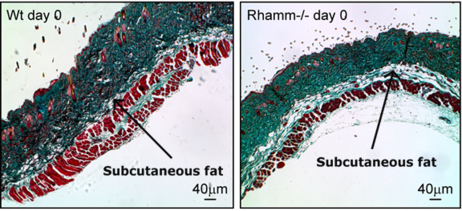Non-Surgical Skin Enhancement Through Rhamm Protein Modulation
This invention is not a product, but an early-stage technology available to qualified companies for licensing or research partnering.Rhamm deletion promotes subcutaneous fat in mice
APPLICATIONS OF TECHNOLOGY:
- Normalizing skin appearance after reconstructive or cosmetic surgery, i.e. grafted tissue on burn victims - Wrinkle reduction – replacement for neurotoxin injections or fillers, e.g. collagen, hyaluronan - Non-surgical face lifts and figure enhancement - Reducing the appearance of cellulite
ADVANTAGES:
- Volumizing effect of a localized injection is expected to be long lasting and does not involve muscle paralysis - Non-surgical treatment - Unlike other adipocyte promoting factors, effects are selective – increases subcutaneous fat while decreasing visceral fat - Should have low toxicity – Rhamm expression is restricted in adult human tissues - Shows a beneficial effect on tumors and inflammatory diseases in mice
ABSTRACT:
Berkeley Lab researchers Mina Bissell and Eva Turley have discovered that regulating the protein Rhamm, receptor for hyaluronan-mediated motility, increases deposition of subcutaneous fat, offering a non-surgical approach for normalizing skin appearance after reconstructive surgery, for wrinkle reduction, and for face lifts and figure enhancement. Unlike neurotoxin agents, which have to be injected periodically, a localized injection of a Rhamm inhibitor should produce long-lasting skin volumizing effects and does not involve muscle paralysis, hence there is no loss of expression if it is injected into the face. The Berkeley Lab technology also holds promise for reducing the appearance of cellulite by smoothing over the pocked area.
While other adipocyte-promoting factors increase visceral as well as subcutaneous fat, mouse studies have shown that blocking Rhamm expression increases subcutaneous fat significantly while decreasing unhealthy visceral fat. Therefore, Rhamm modulation should have a beneficial effect on patients with obesity-related diseases, cardiovascular disease, or diabetes. This is most likely because Rhamm has a selective effect on adipocyte stem cells, regulating mesenchymal stem cells towards myofibroblastic and away from adipocyte lineage.
Another unique advantage of Rhamm as a target is that it has restricted expression in normal adult human tissues. Therefore, anti-Rhamm agents should have low toxicity and according to preliminary animal studies, could be beneficial to patients with a tumor or inflammation-related disease.
Rhamm is a non-integral cell surface and intracellular hyaluronan-binding protein with intracellular and extracellular functions. It is an essential regulator of signaling pathways that impacts mesenchymal, in particular adipocyte, differentiation, particularly during tissue remodeling, e.g. wound repair. This is achieved by both its intracellular effects on signaling pathways such as those regulating MAP kinases and its cell surface effects where it regulates display of key microenvironment receptors such as CD44.
Rhamm inhibiting therapies might include antibodies, soluble recombinant protein fragments, peptides, siRNA, antisense oligonucleotides, or aptamers. For more information on this invention please see the publication link below. Patent Pending.
Attached files:

Inventor(s): Mina Bissell and Eva Turley
Type of Offer: Licensing
« More Medical Patents
